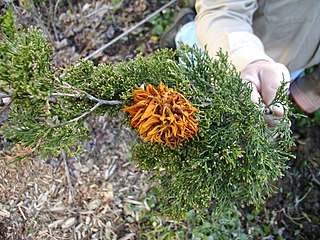
Gymnosporangium is a genus of heteroecious plant-pathogenic fungi which alternately infect members of the family Cupressaceae, primarily species in the genus Juniperus (junipers), and members of the family Rosaceae in the subfamily Amygdaloideae. The common name cedar-apple rusts has been used for these fungi. According to the Dictionary of the Fungi, there was 57 species in the genus. In 2023, Species Fungorum lists up to 74 species.

A heteroecious parasite is one that requires at least two hosts. The primary host is the host in which the parasite spends its adult life; the other is the secondary host. Both hosts are required for the parasite to complete its life cycle. This can be contrasted with an autoecious parasite which can complete its life cycle on a single host species. Many rust fungi have heteroecious life cycles:

Rusts are fungal plant pathogens of the order Pucciniales causing plant fungal diseases.
Galls or cecidia are a kind of swelling growth on the external tissues of plants. Plant galls are abnormal outgrowths of plant tissues, similar to benign tumors or warts in animals. They can be caused by various parasites, from viruses, fungi and bacteria, to other plants, insects and mites. Plant galls are often highly organized structures so that the cause of the gall can often be determined without the actual agent being identified. This applies particularly to insect and mite plant galls. The study of plant galls is known as cecidology.

The quince is the sole member of the genus Cydonia in the Malinae subtribe of the Rosaceae family. It is a deciduous tree that bears hard, aromatic bright golden-yellow pome fruit, similar in appearance to a pear. Ripe quince fruits are hard, tart, and astringent. They are eaten raw or processed into marmalade, jam, paste or alcoholic beverages.
Rust is an iron oxide formed by the reaction of iron and oxygen in the presence of water.
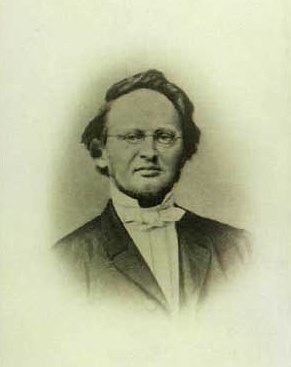
Anders Sandøe Ørsted, also written as Anders Sandoe Oersted or Anders Sandö Örsted was a Danish botanist, mycologist, zoologist and marine biologist. He was the nephew of physicist Hans Christian Ørsted and of politician Anders Sandøe Ørsted.
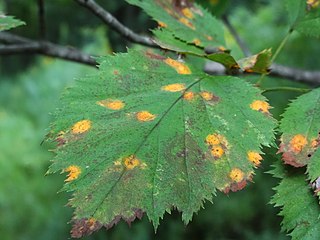
Gymnosporangium globosum is a fungal plant pathogen that causes cedar-hawthorn rust.

Gymnosporangium juniperi-virginianae is a plant pathogen that causes cedar-apple rust. In virtually any location where apples or crabapples (Malus) and eastern red cedar coexist, cedar apple rust can be a destructive or disfiguring disease on both the apples and cedars. Apples, crabapples, and eastern red cedar are the most common hosts for this disease. Similar diseases can be found on quince and hawthorn and many species of juniper can substitute for the eastern red cedars.
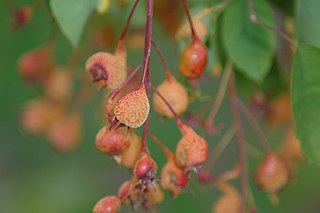
Gymnosporangium libocedri, the Pacific Coast pear rust, is a plant pathogen and rust fungus. It produces orange gelatinous growths (telia) on incense cedar in the spring. Its secondary hosts include apple, crabapple, hawthorn, mountain ash, pear, quince, and serviceberry.
Gymnosporangium yamadae is a plant pathogen that causes Japanese apple rust.
Gymnosporangium nelsonii is a fungal plant pathogen found in North America.

Gymnosporangium sabinae is a species of rust fungus in the subdivision Pucciniomycotina. Known as pear rust, European pear rust, or pear trellis rust, it is a heteroecious plant pathogen with Juniperus sabina as the main primary (telial) host and Pyrus communis as the main secondary (aecial) host.

Aeciospores are one of several different types of spores formed by rusts. They each have two nuclei and are typically seen in chain-like formations in the aecium.

Telium, plural telia, are structures produced by rust fungi as part of the reproductive cycle. They are typically yellow or orange drying to brown or black and are exclusively a mechanism for the release of teliospores which are released by wind or water to infect the alternate host in the rust life-cycle. The telial stage provides an overwintering strategy in the life cycle of a parasitic heteroecious fungus by producing teliospores; this occurs on cedar trees. A primary aecial stage is spent parasitizing a separate host plant which is a precursor in the life cycle of heteroecious fungi. Teliospores are released from the telia in the spring. The spores can spread many kilometers through the air, however most are spread near the host plant.
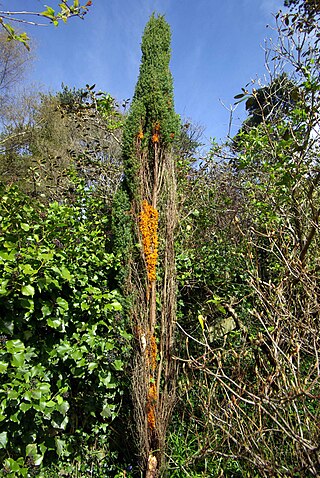
Gymnosporangium clavariiforme is a species of rust fungus which alternately infects Juniperus and hawthorns.

Pristine apple is a hybrid cultivar of 'Co Op 10' x 'Camuzat' domesticated apples, which are descendants of the 'McIntosh' apple and the 'Starking Delicious'. This cultivar was developed and patented in the United States by the PRI disease resistant apple breeding program, in Indiana, United States in 1994, for its resistance to apple scab. It is susceptible to cedar-apple rust.
Frank Dunn Kern was an American plant pathologist and university administrator. He was a faculty member at Pennsylvania State University, holding appointments as Head of the Department of Botany and Dean of the Graduate School. He was an expert on the Pucciniales.
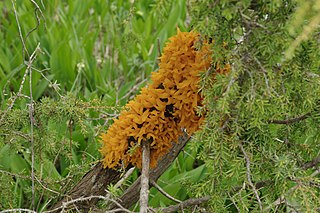
The Gymnosporangiaceae are a family of rust fungus genera, in the order Pucciniales, based on the type genus Gymnosporangium. The classification of fungal taxa based on only morphological characteristics has long been recognised as problematical, so this order was reviewed over a long term study using three DNA loci and published in 2021.














